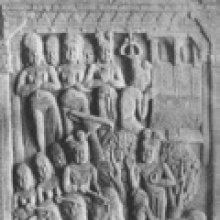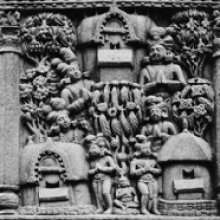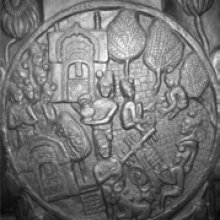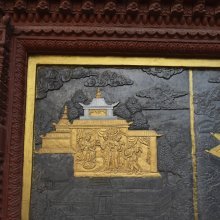Grove: 3 definitions
Introduction:
Grove means something in Hinduism, Sanskrit, the history of ancient India. If you want to know the exact meaning, history, etymology or English translation of this term then check out the descriptions on this page. Add your comment or reference to a book if you want to contribute to this summary article.
Images (photo gallery)
In Hinduism
Yoga (school of philosophy)
Source: ORA: Amanaska (king of all yogas): A Critical Edition and Annotated Translation by Jason BirchGroves (suitable for Yoga practice) are denoted by the Sanskrit term Nikuñja, according to the Parākhyatantra.—The Amanaska’s description of the ideal place in which to practise Yoga is based on four standard characteristics; it should be isolated, solitary, clean and beautiful. Similar descriptions are found in Tantric traditions. [...] The Parākhyatantra, emphasizes seclusion: “In a lonely place, or a grove (nikuñja), or in an agreeable mountain cave, or in an earthen hut that is thoroughly secluded, free from insects, draught and damp”.

Yoga is originally considered a branch of Hindu philosophy (astika), but both ancient and modern Yoga combine the physical, mental and spiritual. Yoga teaches various physical techniques also known as āsanas (postures), used for various purposes (eg., meditation, contemplation, relaxation).
India history and geography
Source: Google Books: Manthanabhairavatantram (history)Groves, Forests and Trees close to human settlements have been venerated throughout the subcontinent up to the present day as the abodes of deities and a range of supernatural beings. References to these beings, of which the most well known type is the Yakṣa and his mate the Yakṣiṇī, are common in early Buddhist and Jain literature. They are well known to art historians also. The Barhut Stūpa and other early Buddhist monuments abound with their images. The earliest standing statue carved in the round so far recovered is the famous Pārkham’s Yakṣa preserved in the museum at Mathura. It was probably made in the third century BCE and may well have stood under a tree.
Source: Suomen Antropologi: Sacred Trees among the Tamil people of South IndiaGroves and Trees (in ancient India) were worshiped for their auspiciousness and the numerous benefits derived from them in the form of food, fodder, medicine and firewood.—In almost every village in Tamil Nadu there is a sacred grove dedicated to a local folk deity. Sacred groves are patches of forests that range from a few trees up to hundreds of hectares that consist of traditionally preserved, almost virgin forests maintained through indigenous cultural and religious rituals practiced by the members of community. They are often islands of biodiversity. [...] many sacred groves are located near important water resources which supply the villagers with their daily water. They also protect the ground from soil erosion.
Certain trees and groves have been pronounced sacred and protected from practices of consumption and management. [...] Sacred groves are not primarily protected in order to benefit the local community’s livelihood support, like common-pool resources (community forests, grazing lands, fish ponds etc.). However, they often play a vital role in protecting and securing important commodities such as, for instance, watershed areas that deliver life-saving water to the whole community

The history of India traces the identification of countries, villages, towns and other regions of India, as well as mythology, zoology, royal dynasties, rulers, tribes, local festivities and traditions and regional languages. Ancient India enjoyed religious freedom and encourages the path of Dharma, a concept common to Buddhism, Hinduism, and Jainism.
See also (Relevant definitions)
Starts with: Grove kweek, Grove sandwort.
Ends with (+18): American mangrove, Bamboo Grove, Black mangrove, Blind-your-eye mangrove, Blindyour-eyes mangrove, Brack-water mangrove, Burma mangrove, Cannonball mangrove, Cedar mangrove, Cigar mangrove, Crabapple mangrove, Four-petaled mangrove, Freshwater mangrove, Gorilla mangrove, Grey mangrove, Holly-leaf mangrove, Holly-leaved mangrove, Indian mangrove, Jetavanna Grove, Large-fruited orange mangrove.
Full-text (+661): Kanana, Upavana, Tapovana, Nishkuta, Vrikshakhanda, Vrikshavatika, Vanika, Amarai, Arama, Nandanavana, Kamaranya, Apavana, Vanya, Dharmaranya, Mishraka, Kelivana, Vanasamuha, Ambevana, Vaibhraja, Kamakanana.
Relevant text
Search found 212 books and stories containing Grove; (plurals include: Groves). You can also click to the full overview containing English textual excerpts. Below are direct links for the most relevant articles:
The Padma Purana (by N.A. Deshpande)
Chapter 111 - Nahuṣa Enters Mahodaya, the City of Huṇḍa < [Section 2 - Bhūmi-khaṇḍa (section on the earth)]
Chapter 102 - Aśokasundarī is Born < [Section 2 - Bhūmi-khaṇḍa (section on the earth)]
Chapter 69 - The Story of Kṛṣṇa Begins < [Section 5 - Pātāla-Khaṇḍa (Section on the Nether World)]
Garga Samhita (English) (by Danavir Goswami)
Verse 2.17.33 < [Chapter 17 - The Meeting of Śrī Rādhā-Kṛṣṇa]
Verse 1.17.16 < [Chapter 17 - Description of the Yogurt Theft]
Verse 2.1.1 < [Chapter 1 - Description of the Entrance in Vṛndāvana]
The Religion and Philosophy of Tevaram (Thevaram) (by M. A. Dorai Rangaswamy)
Chapter 63 - Ciparppatam (Hymn 79) < [Volume 3.5 - Pilgrim’s progress: to the North]
Chapter 86 - Thiruketheeswaram or Tirukketiccaram (Hymn 80) < [Volume 3.7 - Unto the last]
Chapter 23 - Thirumazhapadi or Tiru-Malapati (Hymn 94) < [Volume 3.3 - Pilgrim’s progress: to Chola (later?)]
Ramayana of Valmiki (by Hari Prasad Shastri)
Chapter 39 - Description of Lanka < [Book 6 - Yuddha-kanda]
Chapter 14 - The Ashoka Grove < [Book 5 - Sundara-kanda]
Chapter 42 - The Felicity enjoyed by Rama and Sita < [Book 7 - Uttara-kanda]
Trishashti Shalaka Purusha Caritra (by Helen M. Johnson)
Part 13: Description of Śatruñjaya < [Chapter VI]
Part 3: Attempts to seduce Sītā < [Chapter VI - Bringing news of Sītā]
Part 22: Description of Meru < [Chapter III - The initiation and omniscience of Ajita]




